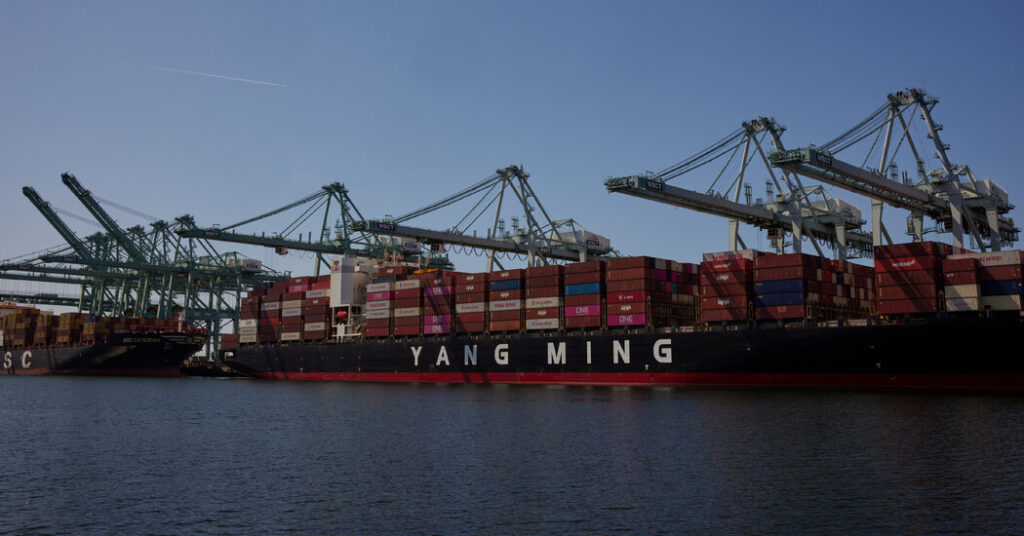President Trump’s latest tariffs are about to become an unavoidable and expensive reality for American businesses and for people who rely on foreign goods.
Shoppers buying clothes from retailers in China may soon pay more than twice as much, now that a special exemption for lower-value imports is disappearing. And companies involved in international trade must now make even more complicated calculations to decide how much they owe in tariffs.
“Maybe 3 percent of the people are well prepared,” said Jeremy Page, a founding partner of Page Fura, an international trade law firm, whose clients include large companies. “And that might even be charitable.”
Imports from China have been hit with tariffs of 145 percent. That means for every $100 worth of goods a business buys from that country, it has to pay $145 to the federal government. Goods from most other countries have a new 10 percent tax, though that could rise if the countries do not reach trade agreements with the United States by July. And there are separate tariffs on cars, steel and aluminum. Mr. Trump has also said he wants to impose new tariffs on pharmaceuticals and computer chips.
Mr. Trump contends that the tariffs will encourage businesses to produce goods in the United States. The tariffs on Chinese goods will almost certainly reduce imports from the country. But American businesses will not be able to quickly get goods from elsewhere — U.S. imports from China totaled $439 billion last year — and they will end up owing huge amounts in tariffs.
Who pays the tariffs?
Mr. Trump has said tariffs are a tax on other countries, but, overwhelmingly, American businesses importing the goods pay the tariffs to the Customs and Border Protection when goods enter the United States. Importers may pass some or all of the cost of the tariff to consumers through higher prices.
“In the short term, prices are definitely going to increase,” said Daniel J. Barabino, chief operating officer at Top Banana, a fruit distributor based at the Hunts Point Produce Market in the Bronx, which imports bananas and other produce from Central America.
Importers may also try to negotiate lower prices with foreign suppliers, which would reduce the tariff.
How are the tariffs paid?
Most importers employ customs brokers who calculate the tariffs owed based on the goods’ value and where they were exported from. Other factors — like whether a product has components from China — can complicate the tariff calculation.
Payments are made electronically, from the bank accounts of either importers or the brokers, who later recoup the money from their clients. As Mr. Trump has piled on tariffs, some brokers are becoming more cautious and demanding customers pay up quickly.
“With changing tariffs and increased risk, many brokers are tightening their credit policies — asking for upfront payments or requiring funds to be held on account,” said Adam Lewis, a co-founder and president of Clearit, a customs broker.
Where does the money go?
The tariffs end up at the Treasury Department, which also receives taxes and other government fees, and spends the money on things like salaries, weapons and equipment.
What happens if a business pays less than it owes?
Calculating tariffs can be difficult, especially when tariff rates change a lot in a matter of days, as they have recently.
Trade rules allow for some leeway, said Mr. Page, the lawyer. Importers who realize they have made a mistake and inform Customs and Border Protection are usually allowed to pay what they owe, plus interest.
But, Mr. Page said, Mr. Trump’s recent executive orders on metals tariffs were stricter than that. The order said Customs and Border Protection could impose much higher monetary penalties if importers misclassified goods, an approach that, in Mr. Page’s view, defies the law.
“That mandate says, ‘We’re going to hammer you no matter what,’” he said.
Will the new tariffs cause delays?
Customs and Border Protection’s systems are already showing signs of strain.
On Friday, the agency said importers had not been able to submit tariffs owed on certain goods. The glitch appeared to be preventing importers from applying a lower tariff rate on goods that were in transit to the United States before some of Mr. Trump’s new levies took effect.
Customs and Border Protection said it was releasing the goods affected by this problem and allowing importers to submit their customs duties later.
“This won’t be the last time that something like this happens,” Mr. Lewis said, adding that there may be backlogs when customs officials do more checks to see if the tariffs on Chinese goods are being paid correctly.
Countries that don’t strike trade deals with the United States by July may face higher tariffs, and Mr. Trump may suddenly decide to introduce new tariffs. Fears of such levies could extend a monthslong rush to get goods into the United States before the new tariffs take effect.
Supply chains have so far handled the higher volumes without major snags.
Trucking activity around Laredo, Texas, one of the busiest border crossings in the United States, was 46 percent higher than it was a year earlier, according to Motive, which gets its data from the tracking devices it provides to trucking companies. Local truckers said their networks had not been strained.
At the Port of Long Beach and Port of Los Angeles, trucks took 71 minutes on average to pick up cargo from terminals in the first three months of this year, according to data from the Harbor Trucking Association, a trade group. That was slightly up from 68 minutes in the first three months of last year. In the first quarter of 2022, when the pandemic trade boom caused backlogs at the ports, pickups took an hour and a half.
Danielle Kaye contributed reporting.
https://www.nytimes.com/2025/04/11/business/economy/trump-tariffs-imports-costs.html


